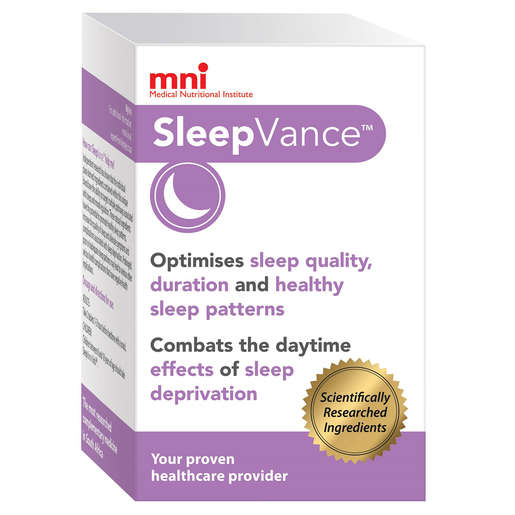
MNI SleepVance Tablets 60
Check my rate
View locations
| Main centres: | 1-3 business days |
| Regional areas: | 3-4 business days |
| Remote areas: | 3-5 business days |

| Main centres: | 1-3 business days |
| Regional areas: | 3-4 business days |
| Remote areas: | 3-5 business days |
SleepVance contains a unique blend of plant-derived phytochemical ingredients and nutrients. This blend can target multiple pathways associated with sleep and mood regulation. SleepVance optimises healthy sleep patterns, increases the quality of sleep, and alleviates symptoms and complications associated with sleep deprivation. Prolonged poor or inadequate sleep patterns may lead to various other serious health complications that have negative health implications.
What can SleepVance assist with?
SleepVance can assist with:
Metabolism is a complex biological chain reaction that fluctuates all day. Anabolism is the set of metabolic pathways that construct new molecules from smaller units, mostly derived from food. While anabolism takes care of the building-up and creational aspects of metabolism, catabolism is responsible for the breaking-down and ultimate degradation of cellular components.
At night, during the sleep cycle, many of the body's systems go into 'anabolic state', a renewal process that is essential for the restoration of the immune, skeletal, muscular, and nervous systems. These are also required to optimally maintain the function of neurons, which ultimately regulate mood, memory, and cognitive function.
One of the most pronounced physiological changes that happens in the body during sleep occurs in the brain. This is because sleep allows the brain to use significantly less energy for 'thinking', thereby allowing it to replenish its energy supply in the form of the molecule ATP (adenosine triphosphate) required for nerve transmission, neurotransmitter production and nerve growth.
What does SleepVance contain?
Valerian root extract
Valerian (Valeriana officinalis) is a flowering plant native to Europe and Asia. Its use as a medicinal herb for sedative purposes and relaxation dates to ancient Greece and Rome, where its therapeutic properties were described by Hippocrates in the early Western medical literature. Extracts of the root have since been used for their calming effects and as a regular supplement to promote sleep.
The bioactive compounds believed to contribute to its mode of action belong to several classes of naturally occurring organic molecules. These include valerenic- and isovaleric acid, gamma-aminobutyric acid (GABA), alkaloids such as chatinine, valerianine, and valerene, and several iridoids; valtrate and isovaltrate.
Valerian's primary usage is to help calm the restless mind and help alleviate anxious thoughts, thereby making it easier to fall and stay asleep without obsessing about stressful matters. Valerian extract's mode of action involves enhanced signalling of the gamma-aminobutyric acid (GABA) pathway, the same neurotransmitter system in the brain that the benzodiazepines, a class of sedative and hypnotic pharmaceutical drugs, therapeutically target.
American Skullcap
American skullcap (Scutellaria lateriflora) is a flowering shrub that grows in meadows and swampy woods in North America. Traditionally, it has been used by early Native Americans and later European settlers as a nerve tonic, sedative, and anticonvulsant remedy. In modern times, it is still therapeutically used in tonic form to alleviate insomnia, anxiety, and neuralgia (nerve pain) in North America, Alaska and Canada.
The main bioactive compounds are several flavones and phenols, of which baicalin, baicalein, wogonin, and oroxylin-A have been the most researched. Several flavones naturally found in skullcap selectively bind with high affinity to central benzodiazepine receptor sites, thereby exerting a similar but non-addictive and milder anxiolytic and hypnotic effect than the class of benzodiazepine drugs.
Passionflower
Passionflower (Passiflora) is a large genus of flowering plants native to Brazil, Paraguay and northern Argentina. They are commercially cultivated in many other regions for their aromatic and flavoursome fruit. Extracts of the roots and leaves, however, have a long history of use as a medicinal herb for relaxation and sedation purposes.
The therapeutically active phytochemicals are the flavonoids (vitexin, isovitexin, apigenin, chrysin, and orientin), indole alkaloids (harman, harmin, harmaline, and harmol) and phenolic acids (formic acid, butyric acid, and GABA). Several of these selectively bind with high affinity to the central benzodiazepine receptor sites and therefore exert a similar but more gentle anxiolytic effect than the class of benzodiazepine drugs.
5-Hydroxytryptophan (5-HTP)
Tryptophan is an amino acid found in high concentration in certain foods such as chocolate, oats, dried dates, dairy products and meat. After ingestion, some tryptophan is metabolised into 5-hydroxytryptophan (5-HTP), which is then directly converted into serotonin and melatonin, two neurotransmitters with a multifaceted biological role involved in sleep regulation, mood control, and cognitive function.
Numerous lines of evidence support the use of L-tryptophan and its direct metabolite, hydroxytryptophan (5-HTP), in the treatment of sleep disorders.
Inositol
Inositol is an organic food compound found in certain fruits, beans, and grains. Structurally, inositol is related to the vitamin B family and performs a similar biochemical function in the body. In the brain, inositol's neurobiological mode of action relates to the neuro-modulatory role it plays in the phosphoinositide (PI) cycle, linked to the production of the neurotransmitters serotonin and noradrenaline, involved in mood regulation and cognitive function.
Anatomically, dietary inositol is incorporated in the brain into the cell membranes of neurons as inositol phospholipids, where they serve as a structural and metabolic precursor to subtypes of adrenergic, cholinergic, and serotonergic neuro-receptors in several neurological tissues. Behavioural and biochemical studies have indicated that inositol has the potential to enhance neuro-receptor sensitivity and modulate neuro-signalling proteins, thereby helping to direct nerve membrane trafficking. As documented in three separate publications in the American Journal of Psychiatry, evidence suggests that inositol supplementation demonstrates superior therapeutic efficacy against placebo regarding emotional well-being, stress reduction, and sleeping patterns relating to conditions which include Panic Disorder,